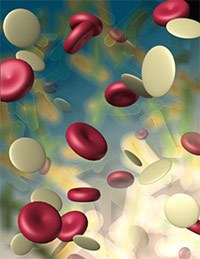Chelation Therapy
Applications of chelation therapy with cancer treatment.

Chelation Therapy in Cancer Treatment
Chelation therapy refers to the injection or consumption of chelating agents for the purpose of eliminating from the body undesirable substances such as heavy metals, chemical toxins, mineral deposits, and fatty plaques. For example, in the arteries, the chelation agent binds to the calcium in plaques.
 Chelating (pronounced key-layting) agents are substances that can chemically bond with metals, minerals, or chemical toxins within the body. The word "chelate" is derived from the Greek language and means "claw". The chelating agent actually encircles a mineral or metal ion and carries it from the body via the urine and feces.
Chelating (pronounced key-layting) agents are substances that can chemically bond with metals, minerals, or chemical toxins within the body. The word "chelate" is derived from the Greek language and means "claw". The chelating agent actually encircles a mineral or metal ion and carries it from the body via the urine and feces.
The most widely used and studied chelating agent is EDTA (Ethylene Diamine Tetraacetic Acid), which is a synthetic amino acid. Where amino acids are the building blocks of protein.
In 1948, chelation therapy with EDTA was first introduced into medicine in the United States as a treatment for lead poisoning of workers from a battery factory. A few years later, the U.S. Navy advocated chelation for sailors who had absorbed lead while painting government ships and facilities. The FDA has approved intravenous EDTA chelation as a treatment for lead poisoning.
Since 1952, intravenous EDTA chelation has been administered to treat cardiovascular disease. Physicians observed, during chelation for lead toxicity, that patients who had arterioscleroses (fatty-plaque buildup on arterial walls) and arteriosclerosis (hardening of the arteries) experienced improvements in both conditions after chelation.
EDTA cannot however chelate mercury. DMSA and DMPS, the chemicals which work intravenously to chelate mercury, are not currently approved for use by the FDA.
In the last 50 years, human exposure to heavy metals has risen dramatically, as a result of increased use of heavy metals in industrial processes and consumer products. Chronic exposure comes from amalgam dental fillings (which are about 50% mercury), lead in paint, tap water, chemical residues in processed foods, and cosmetics.
Over 50 professions incur exposure to mercury. These include physicians, pharmaceutical workers, any dental occupations, laboratory workers, hairdressers, painters, printers, welders, metalworkers, cosmetic workers, battery makers, engravers, photographers, visual artists, and potters.
For more than 40 years, chelation therapy has been used to treat conditions such as cardiovascular disease, diabetic arterial disease, decreased mental function from vascular disease and intermittent claudication (leg pain on exercise).
Different Types of Chelation Therapy Available
- Chelation with Calcium-Disodium EDTA
- Chelation with Magnesium EDTA, in the form of intravenous injections
- Oral EDTA in the form of capsules for preventative purposes
- EDTA suppositories
Chelation Therapy and Cancer Treatment
A Swiss study published in 1980 by Drs. Blumer W., Reich T., reported 90% fewer cancer deaths and 86% less cardiovascular events during an 18 year follow-up period in patients who took a series of 20 preventive chelation treatments.
Chelation Therapy is available at the Issels Treatment Center according to individual indication.